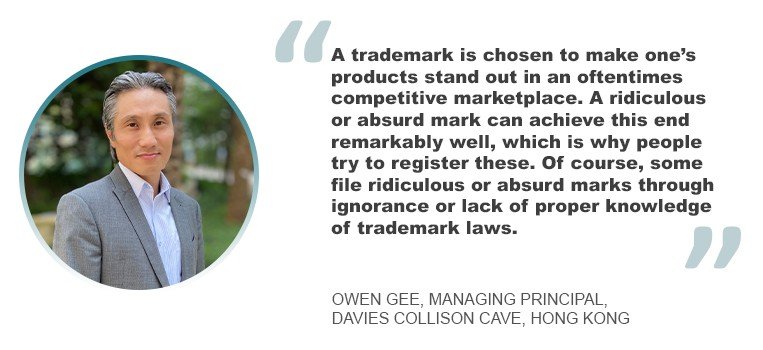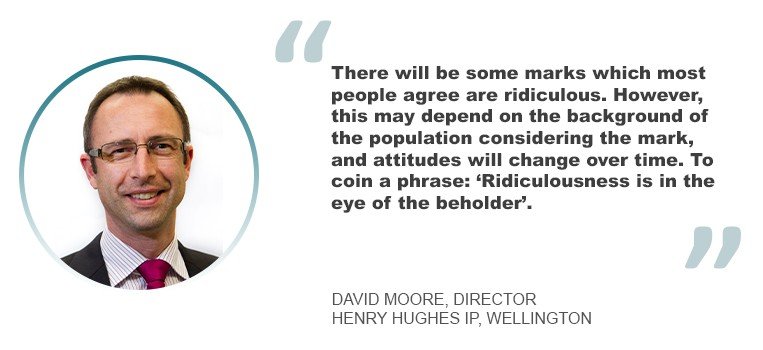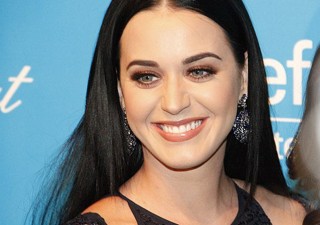When trademark applications become not ordinary
31 October 2023

Between the interplay between creativity and practicality in trademark applications, one can find a series of “ridiculous” trademark applications. Excel V. Dyquiangco explores these instances, including the subjective nature of what is considered ridiculous or absurd.
The filing of trademark applications stands as a vital and legitimate process to safeguard the distinctive identity of a brand, product, or service. However, within this well-defined arena of protection, a curious and occasionally absurd phenomenon emerges – the submission of utterly outlandish trademark applications. These applications, while often amusing and seemingly implausible, shed light on the intricate balance between creativity and practicality in the realm of intellectual property law. This intriguing interplay prompts a closer examination of the motivations, implications, and occasional eyebrow-raising instances that arise when individuals and entities venture into the realm of filing ridiculous trademark applications.
Earlier this year, pop star Katy Perry found herself in a trademark dispute with an Australian fashion designer who goes by the same name. A woman named Katie Taylor, who sells clothing under her birth name Katie Perry, filed a lawsuit against the singer, alleging that merchandise Katy Perry sold on her 2014 Australian tour, violated a trademark Taylor held. A court in the case decided in Taylor’s favor and determined that merchandise sold for Perry’s 2014 tour did in fact violate her trademark.
Owen Gee, a managing principal at Davies Collison Cave in Hong Kong, recounts an amusing trademark application.
He says: “‘All I do is party’ was one mark I was asked to file. The applicant organized parties and other entertainment events under this brand – so the applicant was true to brand! – and wanted protection for promotional clothing. There was a risk that the mark could be seen as merely a laudatory slogan even though limited to clothing. However, we decided to file the mark in the particular form that the applicant intended to use, which visually at least had certain distinctive elements, and the mark proceeded to registration.”
This is supported by David Moore, a director at Henry Hughes IP in Wellington. While he says he doesn’t recall personally prosecuting any particularly unusual trademarks, he has seen some funny and peculiar ones over the years, especially those occurring in slogans.
“Often people apply in Class 25 for slogans which they want to put on T-shirts,” he says. “In my view, the slogans aren’t necessarily functioning as a trademark. But the applicant nevertheless wants to claim protection to stop others selling T-shirts with the same word or slogan. There is a registration for the word ‘CNUT’ in relation to clothing. Presumably this is aimed at history enthusiasts who wish to show their appreciation for the former King of England.”
But what is ridiculous or absurd, anyway?

Gee says that what is “ridiculous” or “absurd” to one person is “clever” or “witty” to another. “A trademark is chosen to make one’s products stand out in an oftentimes competitive marketplace. A ridiculous or absurd mark can achieve this end remarkably well, which is why people try to register these. Of course, some file ridiculous or absurd marks through ignorance or lack of proper knowledge of trademark laws. For example, descriptive, customary, laudatory, promotional phrases, slogans, catch cries, or other marks not sufficiently distinctive to distinguish one’s products from another cannot be registered. Nor can scandalous, profane, or otherwise immoral marks.”

Moore adds that the idea of what constitutes ridiculous or absurd is subjective. “Admittedly, there will be some marks which most people agree are ridiculous. However, this may depend on the background of the population considering the mark, and attitudes will change over time. To coin a phrase: ‘Ridiculousness is in the eye of the beholder’. Often, people will jump on a new trend and attempt to register a newly coined term as a trademark thinking that they can gain commercially from monopolizing a newly popular term. In the mid-2020 some ridiculous applications were filed, including: ‘I survived COVID-19; I survived Coronavirus; I survived Self-Isolation’; ‘COVID-19 2020’; ‘New Zealand 100 percent covid free’; and ‘The new normal is spaced out *covid2020’. All these applications are now abandoned.”
In assessing the validity and uniqueness of a trademark application, in Hong Kong, the mark must be capable of distinguishing one’s products from another’s. This is both in an absolute sense, where the mark must have sufficient distinctive character and not be descriptive or a customary designation in relation to the products, and in a relative sense, where the mark must be sufficiently dissimilar from prior registered marks to not confuse the public. Evidence of use can be used to overcome deficiencies in meeting these criteria.
In New Zealand, the basic test is whether the trademark is a term or image which another person in the same field of business might legitimately need to use to refer to their own products or services. The test must consider the nature of the goods or services covered under the application. Moore says that it is perfectly possible for outlandish terms or everyday words to be registered as trademarks, so long as they are not apt for use in relation to the particular goods or services of the application.
Additionally, a trademark must not be registered in New Zealand if “the use or registration of which would, in the opinion of the Commissioner, be likely to offend a significant section of the community, including Māori”. “This is an interesting area as attitudes to what is offensive will change over the course of time,” says Moore. “There are a number of marks which were registered in New Zealand in the late 1800s and early 1900s which feature Māori imagery which was registerable as a trademark then, but which would be considered offensive (and not registerable) now.”
Potential conflict between two applications
Where two parties attempt to trademark similar, absurdly common words or phrases for vastly different products or services, Gee says that the challenge is greater when the products are similar.
“Where products are vastly different, registration will not likely hinge on the whether the products conflict but will in all likelihood depend on whether the common words or phrases have the requisite distinctive character,” he says. “Before the recent excited chatter around Twitter’s adoption of its new ‘X’ mark, I once had a client who filed an application to register another single letter mark. Although it was accepted that the client’s single letter mark had the requisite distinctive character, a prior registration of the same single letter combined with a plus sign (“+”) was cited against my client’s application on the basis that the marks were similar and the respective products were similar. Even though we did not believe the marks or the products were similar, the client nonetheless decided to narrow the products covered to their core products. The client’s mark was subsequently registered, despite the client’s core products being in the same class as some of the products covered by the cited mark. This demonstrates that provided a common word or phrase, or even a single letter, has the requisite distinctive character, it can be registered alongside a similar common mark if the respective products being covered are dissimilar, even where the products belong to the same class.”






